Mission Names

Mars 2020
The overall name of the mission, which includes the rover
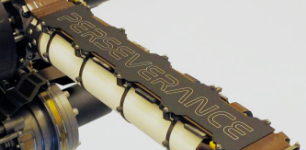
Rover
Perseverance, submitted by Alex Mather, 13, of Lake Braddock Secondary School in Burke, Virginia
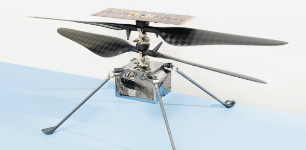
Mars Helicopter (a separate experiment)
Ingenuity, submitted by Vaneeza Rupani, 17, of Tuscaloosa County High School in Northport, Alabama
Spacecraft
Total mass at launch (including rocket; Mars 2020 Perseverance mission components; and Ingenuity Mars Helicopter)
About 1.17 million pounds (531,000 kilograms)
Mars 2020 Perseverance mission major components
Perseverance rover, cruise stage (to fly to Mars), aeroshell (includes the back shell and heat shield to protect the rover as it descends toward the surface) and descent stage (which performs the sky crane maneuver to lower the rover to the surface)
Perseverance Rover
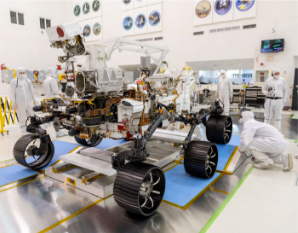 Image credit: NASA/JPL-Caltech |
Image credit: NASA/JPL-Caltech |
Full image and caption
Mass: About 2,260 pounds (1,025 kilograms), including a robotic arm with a 99-pound (45-kilogram) turret at the end
Dimensions: About 10 feet long (not including the arm), 9 feet wide and 7 feet tall (about 3 meters long, 2.7 meters wide and 2.2 meters tall), with a robotic arm that is about 7 feet (2.1 meters) long
Payload Instruments: 130 pounds (59 kilograms) for seven instruments: Mastcam-Z, Mars Environmental Dynamics Analyzer (MEDA), Mars Oxygen In-Situ Resource Utilization Experiment (MOXIE), Planetary Instrument for X-ray Lithochemistry (PIXL), Radar Imager for Mars’ Subsurface Experiment (RIMFAX), Scanning Habitable Environments with Raman & Luminescence for Organics & Chemicals (SHERLOC) and SuperCam
Sample Caching System: 1 bit carousel with 9 drill bits for sample acquisition and surface analysis, 1 1.6-foot-long (0.5-meters-long) internal sample handling arm and 43 sample collection tubes, including 5 “witness” tubes
Power: Multi-Mission Radioisotope Thermoelectric Generator (MMRTG) provided by the U.S. Department of Energy that uses the natural decay of plutonium-238 to generate a steady flow of about 110 watts of electricity. Two lithium-ion rechargeable batteries are available to meet peak demands of rover activities when the demand temporarily exceeds the MMRTG’s electrical output levels.
Microphones: 1 on SuperCam and 1 on the side of the rover for public engagement and later entry, descent and landing analysis
Ingenuity Mars Helicopter
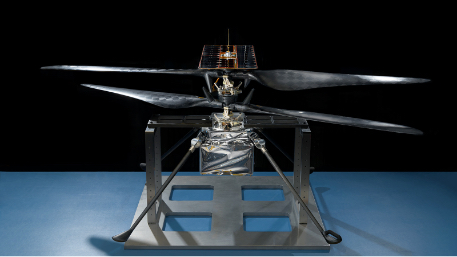 Image credit: NASA/JPL-Caltech | Full image and caption
Image credit: NASA/JPL-Caltech | Full image and caption
Mass: about 4.0 pounds (1.8 kilograms)
Height: 1.6 feet (0.49 meters)
Rotor system: Two pairs of counter-rotating blades, spanning 4 feet (1.2 meters) in diameter, spinning at about 2,400 rpm
Fuselage (body) dimensions: 0.446 feet by 0.64 feet by 0.535 feet (13.6 centimeters by 19.5 centimeters by 16.3 centimeters); four legs, each about 1.26 feet (0.384 meters) long, giving the helicopter about 0.427 feet (0.13 meters) of clearance above the ground
Power: Solar panel that charges lithium-ion batteries, providing enough energy for one 90-second flight per Martian day (about 350 watts of average power during flight)
Cameras
The Mars 2020 Perseverance mission is ferrying 25 cameras to the Red Planet — the most ever flown in the history of deep-space exploration.
19 cameras total on the rover: 9 for engineering (color); 3 for entry, descent and landing (1 black-and-white dedicated to Terrain-Relative Navigation and 2 color for public engagement and engineering reconstruction of entry, descent and landing); 2 for Mastcam-Z (color with zoom); 1 for SuperCam (color); 2 for SHERLOC (color); 1 for PIXL (black-and-white with some color capabilities); and 1 for MEDA (black-and-white)
3 cameras on the back shell: all color, all looking up to capture parachute inflation
1 camera on the descent stage: color, looking down to view the rover from above
 Image credit: NASA/JPL-Caltech | Full image and caption
Image credit: NASA/JPL-Caltech | Full image and caption
2 cameras on Ingenuity: 1 color with an oblique view for terrain images and 1 black-and-white for navigation
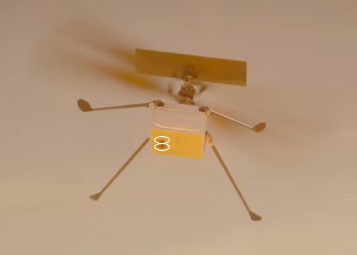 Cameras circled in white. Image credit: NASA/JPL-Caltech | + View Larger Image
Cameras circled in white. Image credit: NASA/JPL-Caltech | + View Larger Image
Launch
Update: As of June 24, the launch is targeted for no earlier than July 22, 2020. Additional updates can be found on the mission’s launch page.
Targeted Launch Period: no earlier than July 20 to Aug. 11, 2020
Targeted Launch windows: 9:15 a.m.-11:15 a.m. EDT (6:15 a.m.-8:15 a.m. PDT) on July 20, with additional times listed on the mission’s launch page
Launch site: Space Launch Complex 41, Cape Canaveral Air Force Station, Florida
Launch vehicle: Atlas V 541 from United Launch Alliance
Earth-Mars distance on July 20, 2020: 65 million miles (105 million kilometers)
Spacecraft’s distance traveled, Earth to Mars (July 20 launch): 309 million miles (497 million kilometers)
Surface Mission
 Image credit: NASA/JPL-Caltech | Full image and caption
Image credit: NASA/JPL-Caltech | Full image and caption
Time of Mars landing: Feb. 18, 2021, shortly after 3:30 p.m. EST (12:30 p.m. PST), to be made more precise depending on the launch date and time. If launch is July 20, 2020, the time of day at the landing site will be 3:46 p.m. local mean solar time
Landing site: Jezero Crater, about 18 degrees latitude, 77 degrees longitude
One-way light time (the time it takes radio signals to travel): Mars to Earth, on Feb. 18, 2021: about 10.5 minutes
Perseverance mission duration: At least one Mars year (about 687 Earth days)
Number of samples able to be collected: At least 30
Ingenuity flight test duration: Up to 30 Martian days (about 31 Earth days)
Mars
 Image credit: NASA/JPL-Caltech |
Image credit: NASA/JPL-Caltech |
Full image and caption
Size: About half the size of Earth, but twice the size of Earth's Moon. As a desert planet, Mars has about the same amount of surface area as the dry land on Earth
Mass: About 10% that of Earth
Gravity: About 38% as strong as Earth’s
Orbit: Elliptical and about 1.5 times farther from the Sun than Earth is (about 141.5 million miles or 227.7 million kilometers from the Sun, on average)
Year: 1 Mars year (1 revolution about the Sun) takes 687 Earth days
Day: 1 Mars day (1 rotation) is 1.027 longer than an Earth day (24 hours, 39 minutes, 35 seconds)
Atmosphere: About 1% the density of Earth’s atmosphere at the surface
Temperature: Surface temperature averages minus 64 Fahrenheit (minus 53 Celsius); varies from minus 199 Fahrenheit (minus 128 Celsius) during polar night to 80 Fahrenheit (27 Celsius) at equator during midday at closest point in orbit to Sun
Program
NASA has invested approximately $2.4 billion to build and launch the Mars 2020 Perseverance mission. The estimate to land and operate the rover during tis prime mission is approximately $300 million.
NASA has invested about $80 million to build the Ingenuity Mars Helicopter and about $5 million to operate the helicopter.



 Image credit: NASA/JPL-Caltech |
Image credit: NASA/JPL-Caltech |